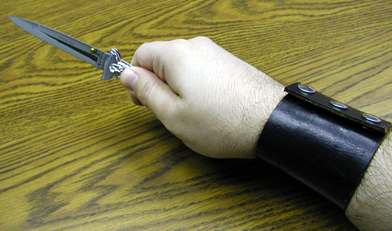its paid sponsors, whose products you need!
“Stay ‘unreasonable.’ If you
don’t like the solutions [available to you], come up with your
own.”
Dan Webre
The Martialist does not
constitute legal advice. It is for ENTERTAINMENT
PURPOSES ONLY.
Copyright © 2003-2004 Phil Elmore, all rights
reserved.
Drills for Knife Training
By Phil Elmore
WARNING!
Knife training is an inherently dangerous activity.
The Martialist disclaims any liability resulting
from injuries sustained while training using any concepts contained
herein.
I’ve discussed at length the
continuum
of training knives. In it, I refer to active sparring, training
disarms and defenses, and training the forms and mechanics of knife
fighting. These are drills for knife training. They represent
the “practice” of learning to use a knife for self-defense.
The explanations and permutations of the drills listed here are by no
means inclusive, but these suggestions should get you started in your own
training.
Active sparring is the best of all knife drills,
provided one spars against a variety of opponents. (If you always
spar the same person, you’ll develop bad habits, because you’ll be
prepared to spar only that particular person.) In active sparring,
two (or more) individuals armed with soft rubber training
knives or marking blades duel
each other. Such a drill develops reflexes, speed, flow, timing, and
the proper mindset for knife fighting.
Active sparring is itself a drill, rather than a
category of drills. All you need is a willing partner against whom
to test your skills.
Disarms and defenses are those drills that
involve “defanging the snake” or simply deflecting an incoming
knife attack. Rigid training knives are best for this because many
disarms involve using leverage to take or trap the knife. A flexible
“knife” would be unsuitable for such training. Training
disarms and defenses requires the willing partner to “attack” with a knife — at slow speed at first — while the
defender practices deflecting, trapping, and taking the
“blade.” Special care must be taken to avoid injuring the
training partner doing drills of this type, as it is very easy to harm
someone’s joints in this fashion.
The drills will vary depending on the
techniques used (specific knife defense techniques are beyond the scope of
this article) and the style in which one trains.
Disarms and defenses are best trained under qualified
instructor supervision. Be aware that a rigid training knife is
potentially dangerous, especially if thrust into an eye or the
throat. While training disarms and defenses it is very easy to get into bad habits, hurt the
“attacker,” or experience injury as the
“defender.” Wear protective gear as appropriate.
Drills for training forms and mechanics can be as
simple as watching yourself in the mirror or watching your own shadow on
the wall as you move through the mechanics and flow of your particular
fighting style. Aluminum trainer blades are best for this purpose,
as they are closest to live blades (and thus help you develop the
appropriate mindset for wielding the knife) but still relatively safe if you make a
mistake.
HANGING OBJECT TARGETING AND CUTTING
Hanging object targeting can be done with training knives or with
live
blades. Using tennis balls, ping pong balls, sheets of
paper, pieces of cardboard, or other suitable targets, hang the targets
from a wall or ceiling with cord or string. Using your knife or
trainer, practice stabbing and slashing at the targets to get the feel for
hitting where you’re aiming. For best results, hang targets at
different heights.
Always use extreme caution when
test-cutting with a live blade! I once stabbed myself
in the arm performing a swinging cut with a double-edged dagger that
missed its target and landed in the inside of my forearm. One very
useful piece of equipment is a simple pair of leather wrist cuffs.
Remember that your knife can maim and even kill you. Respect it.

Wrist cuff obtained from
Combat
Technologies.
HANGING BOTTLE TEST CUTTING
Alliance
Martial Arts lists some useful drills for knife and self-defense
training. Pete Kautz of Alliance wrote a very good article for Knifeforums Magazine in which he described test cutting using hanging
plastic bottles. This is a good drill and one in which anyone could
engage. Targets can be empty or full of water (with predictably
messy results). This is really just a variation on the hanging
object targeting drills, the stipulation being that the targets are
bottles. Do not use glass!
I like to use heavy jugs such as those in which Arizona
Iced Tea is packaged. The jug below was sliced by a Cold Steel
Tai
Pan while hanging from the ceiling.

Arizona Iced Tea jug (very thick
plastic) slashed with Cold Steel
Tai Pan.
PURCHASED DUMMY TARGETING
More than one human-shaped punching “bag” exists on the
market. Buying one of these is a quick and easy way to practice
accurate targeting against a person-sized opponent. Training knives
are used for this purpose, obviously, because live blades would carve up
and destroy the dummy.
DUMMY TEST CUTTING
There are a number of different ways to construct a test-cutting
dummy. The most common methods involve some type of hard core — PVC
or wood, for example — covered in padding of foam or layers of
cloth. Duct tape is usually used to wrap the padding (and can be
used to extend the life of the cutting dummy). The object is to
create something that provides resistance but which can be cut from the
outside to a harder core (which simulates bone). This gives the
knife wielder some idea of what to expect when striking a human
target. The design of the dummy is really up to you. Use your
imagination and experiment with different methods.
CUTTING MEAT
Cutting slabs of meat is another way to get some idea of the resistance
one’s blade will encounter against a human target. (I don’t have to
tell you where to go obtain meat — I think you can figure that part
out yourself.) Slashing into a slab of beef will also impress on you
the damage a sharp knife can do to the human body with very little effort.
CAUTIONS
Remember that the purpose of training drills is to develop the skills
necessary for wielding a knife effectively for self-defense.
Practicing a lot of flashy, useless maneuvers that look impressive but
have no application is a waste of your time and may cause you to do
something foolish in the stress of a real encounter. When performing
these drills and in devising drills of your own, always ask yourself a few
questions:
- What skill does this drill develop?
- Will the drill create bad habits as performed?
- What is the application of the skill developed?
- Is there a way to develop this skill more efficiently?
Never train when you are tired, either physically or
mentally.
Use your head and stay safe while
learning what you must learn to protect yourself.
